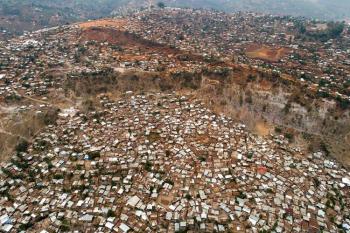Urbanization in the tropics can accelerate the movement of large landslides

Does the movement of a landslide change when a city is built on it? New research shows how more than 70 years of urban growth have disturbed the displacements of a large and now densely-inhabited landslide in the city of Bukavu, in eastern DR Congo. This is what researchers from the Royal Museum for Central Africa, in collaboration with partners from Africa, North America and Europe established from an analysis of hundreds of satellite images combined with historical photographs dating back to 1940’s. The study was published on Monday 5th December in Nature Geoscience.
Urbanization and natural hazards
Human activities are transforming landscapes at rates and scales unprecedented in history. These changes are particularly drastic in economically developing countries of the tropics, where major demographic and economic shifts are driving unparalleled rates of urbanisation. In many regions of Africa and Asia for instance, young urban centres are expanding in a rather informal way, often overlooking natural constraints from the environment, and ultimately drastically increasing the population exposed to natural hazards.
On urbanized hillslopes, dozens of lives are claimed annually by small but high-velocity landslides that may wipe out houses in seconds. But slower and larger – sometimes km² in extent – landslides can also be present, here acting as a more pervasive hazard by causing progressive destructions of houses and infrastructure on entire neighbours over decadal timescales. These slow-moving landslides typically show long-term motion characterised by the succession of periods of relative dormancy and acceleration in response to natural stress perturbations (for example, seasonal precipitation, droughts or earthquakes). For instance, we often observe higher landslide velocities (e.g., from a few centimetre to a few dozen of centimetre per year) during wet seasons and complete or partial stop during dryer months. Yet, these insights on slow-moving landslide behaviour are primarily based on study of landslides in natural environments – typically sited in high-income/high-latitude countries (e.g., the Alps). As a result, our overall understanding of how constraints on the landscapes typical for the tropics such as informal urbanisation affect landslide processes remains very limited.

The large landslide in Bukavu in 1959 (left) and 2018 (right). The yellow dotted line delineates landslide. The very steep scarp that delimits the upper part of the landside is 100 meter high. Left photo: © RMCA; right photo: © A. Dille RMCA
Large slow-moving landslides, natural processes that are sensitive to urbanization
In a new study, researchers from the Royal Museum for Central Africa (RMCA) quantify for the first time how progressive hillslope urbanization changes the dynamics of slow-moving landslides. To this end, they study the seasonal, annual and multi-decadal motion of a large slow-moving landslide located in the rapidly expanding city of Bukavu in eastern Democratic Republic of the Congo (DR Congo). Seen as a safe haven in a region where violent conflicts have forced thousands to move over the past decades, the city of Bukavu is exemplative of the many cities in the tropics facing rapid and informal growth. Here originally established along the flat shoreline of the southern tip of Lake Kivu, the city progressively expanded on the steep – and landslide-prone – slopes of the Kivu Rift. Today, about one-third of the city is built on large deep-seated landslides.
This research was conducted in the framework of the MODUS project, a STEREO-III project funded by the Belgian Federal Science Policy Office (BELSPO), and coordinated by the Royal Museum for Central Africa.
More information about this publication can be found on the following links:
- Science News of the Africamuseum
- Scientific article: Dille et al. 2022, Acceleration of a large deep-seated tropical landslide due to urbanization feedbacks, Nature Geoscience, 10.1038/s41561-022-01073-3
